|
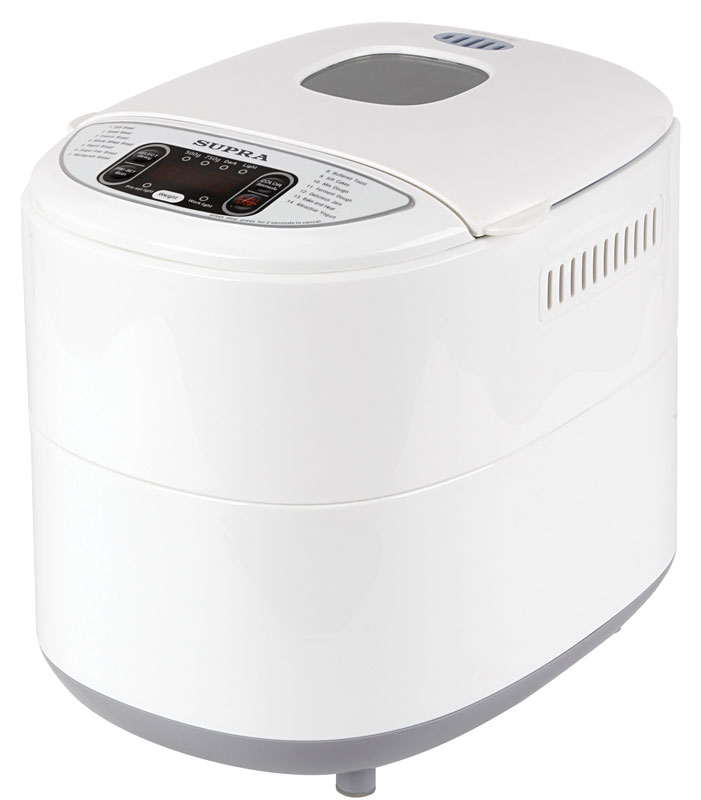
General characteristics
- Power 600 watts
- Maximum baking weight 700 g
- Adjusting the baking weight there is
- Baking form loaf
- Choice of crust color there is
- Timer there is
- Maintaining temperature yes, up to 1 h
Programs
- Number of baking programs 14
- Dough kneading there is
- Accelerated baking there is
- Custom mode no
- Wholemeal bread there is
- Jam there is
- French baguette there is
- Wheat bread there is
- Cake there is
- Sweet pastries there is
Additional Information
- Number of kneaders 1
- Dispenser no
- Display backlight there is
- Body material plastic
- Features: yogurt
Safety instructions
Breadmaker device
Control Panel
Keep warm function
Cleaning and maintenance
Ingredients for baking bread
Ingredient Measurement System
SAFETY NOTE
When designing and manufacturing our products, we strive to make safe using them.
In addition, we ask you to observe the usual safety precautions when working with electrical appliances and to observe the following precautions:
Before using this appliance for the first time, please read this instruction manual carefully and retain it for future reference.
Make sure that the mains voltage and power outlet correspond to the value indicated on the appliance.
If the outlet of the power source is incompatible with the plug of the device, make the necessary replacement of the outlet with the help of qualified specialists.
The electrical safety of the appliance is only guaranteed if it is connected to an adequate earthing source in accordance with current electrical safety regulations. If in doubt, consult a qualified technician.
It is not recommended to use adapters, tees and / or extension cords to connect the device. If necessary, use only adapters and extension cords that comply with current safety regulations and are rated for the appropriate power. In this case, you must ensure that the power limit indicated on the adapter is not exceeded.
It is forbidden to operate the breadmaker under the control of external timers or other remote control systems that regulate the on / off of the device.
Packaging components (plastic bags, polystyrene foam, etc.) should be kept out of the reach of children as they are potential sources of danger.
This appliance should only be used for domestic use. Any other use is considered inappropriate or dangerous.
The manufacturer is not responsible for damage caused by improper, erroneous or inappropriate use of the device, as well as for repairs carried out by unqualified personnel.
Do not touch the appliance with wet or damp hands or feet.
To avoid electric shock, keep the device away from water or other liquids. Do not plug in the appliance if it is installed on a damp surface.
Place the device on a horizontal, dry, hard and stable surface.
Do not use the appliance near heat sources such as a stove.
Do not allow children to use the appliance unattended.
This device is not intended for use by persons with reduced mobility or mental capabilities (including children under 8 years of age), or by persons without relevant knowledge and experience. The device may only be used under the supervision or guidance of a person responsible for its safe use.
Children are prohibited from playing with the device.
To increase the safety of using the device, it is recommended to install a residual current device (RCD) in the power supply circuit for a current not exceeding 30 mA. Take advantage of the advice of a qualified professional.
Do not leave the switched on bread maker unattended as it can become a source of danger.
Do not bend or pinch the cord and be careful not to walk on it.
When unplugging the power plug, never pull on the power cord, but grasp the power plug.
Unplug the appliance before starting any cleaning and maintenance operations.
If the device breaks down or does not work properly, stop using it, turn it off and do not try to repair it yourself. In case of need for repairs, contact only a service center certified by the manufacturer.
If the power cord of this product is damaged, contact an authorized service center to have it replaced.
Do not use or place any part of this appliance on hot surfaces (gas or electric hobs or stoves).
Do not use chemically active or abrasive cleaning agents.
Do not touch hot surfaces of the device. Use potholders or mittens.
Do not touch the moving parts of the bread maker during operation.
It is not recommended to turn on the bread oven unnecessarily if a baking dish with ingredients is not installed in it.
Allow the bread maker to cool before cleaning.
Do not immerse the breadmaker, power cord or plug in water or other liquid or spray it with water.
Always remove the baking dish from the oven chamber to add ingredients.
Do not store anything in the oven chamber.
Do not block the steam vents and provide adequate ventilation for the stove during operation. Position the oven so that there is a gap of at least 5 cm between the body and the walls.
BAKERY DEVICE
NOTE:
All images in this manual are examples, actual product may differ from images.
1 - Cover with a viewing window
2- Control panel
3- Display
4- Furnace body
5- Measuring glass
6 - Measuring spoon (large (table) - 15 ml and small (teaspoon) - 5 ml)
7- Shoulder
8- Baking dish
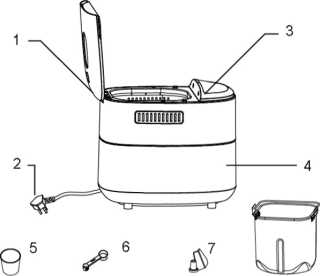
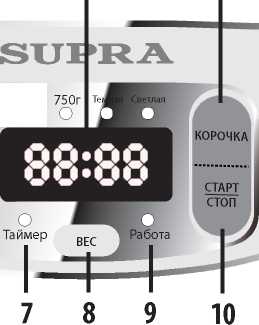
7 - Indicator of the included timer
8 - WEIGHT button - selection of bread weight
9 - Work indicator
10- START / PAUSE / STOP button - turn on / pause / turn off the cooking mode.
USING THE APPLIANCE
Preparation for use
After removing the device from its packaging, check that it is in perfect condition.
If there is any damage to the device or accessories, contact the service center.
Remove all packing materials and all stickers from the surface and interior of the instrument except the model name and serial number.
Clean all food contact parts of the appliance as described in the appropriate section of this manual.
Place the appliance in the designated place. Do not place a baking dish inside. Close the lid of the bread maker.
Plug the power cord into an electrical outlet, making sure that the plug and outlet are securely connected.
Turn on the Bake mode for 10 minutes. When the bread maker is first heated, odor and a small amount of smoke may form due to burning of the transport grease and coating of the heater surface. Let the bread maker cool for 30 minutes.
Once it has cooled down, clean again as described in the appropriate section of this manual.
Dry all parts thoroughly. The bread maker is now ready for use.
Turning on the device
Place the spatula on the spindle in the center of the baking dish.
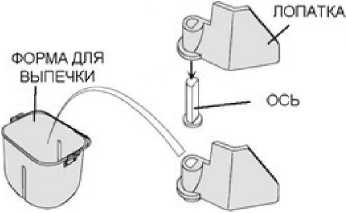
Place food in a clean baking dish, then place the baking dish in the body of the bread machine.

Make sure that the mold fits without distortion and that the rotation of the kneading paddle is engaged. Close the cover firmly.
Plug the power cord into an electrical outlet, making sure that the plug and outlet are securely connected. The oven is now in standby mode.
Selecting a cooking program
Button MENU serves to select a program. Each press of the button changes the program. You can install one of 14 programs. In this case, the display will show the number of the selected program and the time required for its execution.
The features of each of the programs are described below.
1. Normal: kneading, lifting and baking regular bread.
At a certain time, 10 beeps will sound, and you can add additional ingredients to the dough, according to your personal preferences.
2:04 (for 500g) and 2:28 (for 750g) before the end of the program, you will hear sound signals indicating the time for adding ingredients (grains, nuts, etc.) to flavor the bread.
Beeps will sound 1:30 before the end of the program, indicating the time to add ingredients (sesame seeds, caramel, etc.) to give the bread its appearance.
2. Sweet: kneading, lifting and baking bread with a high sugar content or the addition of fruit juices, raisins, chocolate, etc.
At 2:05 (for 500g) and 2:18 (for 750g) before the end of the program, beeps will sound, indicating the time for adding ingredients (grains, nuts, etc.) to add flavor to the bread.
At 1:30 (for 500g) and 1:35 (for 750g) before the end of the program, sound signals will sound, indicating the time for adding ingredients (sesame, caramel, etc.) to give the bread its appearance.
3. French: kneading, lifting and baking bread. In this mode, the dough takes longer to rise. The bread is crispy and light in texture. Do not use this program to bake bread that contains butter, margarine or milk.
At 2:06 (for 500g) and 2:16 (for 750g) before the end of the program, beeps will sound, indicating the time for adding ingredients (grains, nuts, etc.) to flavor the bread.
At 1:35 (for 500g) and 1:45 (for 750g) before the end of the program, sound signals will sound, indicating the time for adding ingredients (sesame, caramel, etc.) to give the bread its appearance.
4. Whole Grain: kneading, lifting and baking whole grain bread.
At 2:15 (for 500g) and 2:25 (for 750g) before the end of the program, beeps will sound, indicating the time for adding ingredients (grains, nuts, etc.) to flavor the bread.
At 1:40 (for 500g) and 1:49 (for 750g) before the end of the program, sound signals will sound, indicating the time for adding ingredients (sesame, caramel, etc.) to give the bread its appearance.
5. Fast: kneading, raising and breading in less time than the main program.
Bread made with this program is usually smaller and denser than the Normal program.
6. Diet: kneading, lifting and baking bread, the recipe for which does not contain sugar ..
At 2:21 (for 500g) and 2:34 (for 750g) before the end of the program, beeps will sound, indicating the time for adding ingredients (grains, nuts, etc.) to add flavor to the bread.
At 1:45 (for 500g) and 1:58 (for 750g) before the end of the program, sound signals will sound, indicating the time for adding ingredients (sesame, caramel, etc.) to give the bread its appearance.
7. Multi-grain: kneading, lifting and baking bread from flour of different types of grains.
At 2:15 (for 500g) and 2:24 (for 750g) before the end of the program, beeps will sound, indicating the time for adding ingredients (grains, nuts, etc.) to flavor the bread.
At 1:40 (for 500g) and 1:45 (for 750g) before the end of the program, sound signals will sound, indicating the time for adding ingredients (sesame, caramel, etc.) to give the bread its appearance.
8. Test: kneading, lifting and baking bread with an elastic structure and a thin crust.
2:00 (for 500g) and 2:05 (for 750g) before the end of the program, you will hear sound signals indicating the time for adding ingredients (grains, nuts, etc.) to give the bread flavor.
1:25 before the end of the program, beeps will sound, indicating the time for adding ingredients (sesame, caramel, etc.) to give the bread its appearance.
9. Cupcake: Bake a muffin (recipe with baking soda or baking powder) for 60 minutes.
10. Kneading: kneading dough for dumplings or dumplings for about 15 minutes, stirring other non-solid foods
11. Fermentation: kneading the dough until tender.
12. Jam: preparation (cooking for about 1 hour 20 minutes) preserves and jams.
13. Yogurt: exposure at a temperature of about 38 ° C for 6-13 hours. The time is adjusted by several clicks of the Timer button.
14. Baking: only baking for 10-60 minutes without pre-kneading and raising the dough. Also used for baking in other programs. The program time is adjusted by a few clicks of the Timer button.
Other oven settings
After selecting the desired program and, if necessary, select the desired weight by pressing the button WEIGHT.
Note: This setting is not available in modes 9-14.
Then, if necessary, select the desired degree of roasting of the bread by pressing the button KORCH-KA.
Note: this setting is not available in modes 5,6,9-14.
Then, if necessary, set the time
Sv \ start cooking by pressing the buttons EP.
Note: timer setting is not possible in modes 9,10,12-14.
Then, by pressing the button START / STOP enable the execution of the specified program.
You will hear a beep and the program will start.
If necessary, temporarily interrupt the operation of the bread machine - press the button START / STOP - the device will go into pause mode. The numbers on the display and the operation indicator flash. To continue work - press the button START / STOP.
Note: Audible signals automatically warn you that the pause mode is on after about 2 minutes.
If necessary, stop the operation of the bread machine - press and hold the button for 2 seconds START / STOP - the device goes into standby mode.
During the execution of some programs (see the description of the programs), the bread-maker will sound several beeps some time after the start of work. This is a signal that now you can (need) add ingredients (nuts, fruits, etc.) in accordance with the recipe to improve the taste of the bread. Open the oven lid and add the required ingredients. After a few seconds, the oven will continue to operate.
During the execution of some programs (see the description of the programs) the bread-baker will give several sound signals some time after the start of work. This is a signal that now you can (need) add ingredients (nuts, fruits, etc.) in accordance with the recipe to improve the appearance of the bread. Open the oven lid and add the required ingredients. After a few seconds, the oven will continue to operate.
Timer, delayed cooking
Using the buttons TIMER you can set the time after which the bread is ready. The timer time set must include the running time of the selected program. The maximum possible time for setting is 15 hours.
First select the program, bread weight and crust color and then use the button TIMER
Utime. Every button press EP increases the timer by 30 minutes.
Example:
It is 20:10 now, and you need to Usual the bread was ready in the morning by 7 o'clock, i.e. after 10 hours and 50 minutes. Place the ingredients in a baking dish. Place the format in the oven. Install the menu program - Usual. The display will show the time required to complete this program. Then by pressing the button TIMER, set the timer time "10:30" (closest to the desired "10:50" value). Then press the button START / STOP, to activate the timer.
In the morning at 6:40 am, the oven will have ready-made hot bread, and the keep warm function will automatically turn on for 1 hour.
NOTES:
The timer function is not available for some programs (see program descriptions).
Do not use the timer function if your bread contains perishable food such as eggs, fresh milk, fruits, onions, etc.
Keep warm function
The prepared bread will be automatically kept warm for 60 minutes after baking. This function is not available in all modes (see the description of the programs).
When this function is active, the display shows the digits "0:00".
Ready baked goods
If you want to take out the bread before the keep warm function ends, first turn off the heating by pressing the START / STOP button, and then remove the bread.
Non-volatile memory
In the event of a brief power failure during the preparation of bread, the baking process will automatically resume after the power supply is restored, even without pressing the START / STOP button, if the power has been disconnected for no more than about 15 minutes. If a power outage lasts more than about 15 minutes, the settings are not saved and the oven program must be restarted.
If cooking has not gone beyond the first mixing stage, when the power outage occurs, you can press the START / STOP button to start the program over - that is, you do not need to change the ingredients for cooking.
TIPS FOR USING THE OVEN
Forming ingredients
1. Place the baking dish on a horizontal surface. Lock the kneading paddle to the paddle shaft. Before installing the spatula, it is recommended to lubricate the spatula and the axle with oil in order to avoid sticking of the dough, and also to facilitate easier removal of the bread from the spatula.
2. Place the ingredients in a baking dish. Follow the order of the recipe. Usually, water or other liquid ingredients are poured in first, then flour, sugar and salt are added, and yeast or baking powder is added last.
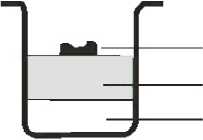
Yeast,
SALT, ETC.
Flour, egg powder ETC. Water, milk etc.
3. Make a small hole in the flour and put the yeast in it, make sure the yeast does not come into contact with liquid or salt.
Removing the finished product
Open the lid, then, using oven mitts, grasp the handle of the baking dish firmly, gently pull the baking dish straight up and out of the breadmaker.
ATTENTION:
The baking dish and the bread itself can be very hot! Be careful with them!
Let the baking dish cool before removing the bread. Then use a non-stick spatula to gently separate the edges of the bread from the sides of the pan.
Turn the baking dish upside down over a clean kitchen wire rack or board and shake gently until the bread falls onto the wire rack or board.
When you are not using or finished using the bread maker, unplug the power cord from the wall outlet.
ATTENTION:
Before slicing the bread, use an object to hook and pull out the kneading spatula hidden on the underside of the loaf. The bread can be very hot, never remove the kneading paddles by hand.
Indoor temperature
The machine can operate at different temperatures, but the quality of bread baked at very high or very low ambient temperatures will differ. Optimal room temperature from 15 ° C to 34 ° C.
Display warnings
If, after turning on the oven or starting the program, if the message "C-NN", "L-NN", etc. "appears on the display, this means that the oven automation has detected a malfunction and the program has been stopped. In this case, you should try to eliminate the malfunction, guided by the recommendations from the table POSSIBLE FAULTS AND REMEDY.
If you are unable to rectify the problem yourself, contact the manufacturer's authorized service center.
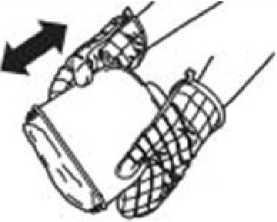
Remove the bread carefully from the mold and let it cool for about 20 minutes before slicing.
If you left the room or did not press the button START / STOP at the end of the program, the bread will be kept warm for 1 hour and then the power will turn off. To deactivate the keep warm function and remove the bread, press the button START / STOP.
INGREDIENTS FOR BAKING BREAD
1. Bread flour
Bread flour has a high gluten content (also called high gluten flour, which is rich in protein). This flour has good elasticity and allows the bread to retain its volume after being raised. Only special bread flour can be used to make bread with a larger volume and better internal structure. Bread flour is the main ingredient for making bread.
2. Plain flour
Flour that does not contain baking powder is suitable for making quick bread.
3. Whole grain flour
Whole grain flour is made from unrefined grains. It contains wheat husk and gluten. Whole grain flour is heavier and more nutritious than regular flour. Bread made with whole grain flour is usually small in size. Many recipes suggest mixing whole grain and bread flour for best results.
4. Dark wheat flour
Dark wheat flour, or so-called “wholemeal flour”, is a flour with a high dietary fiber content, similar in properties to whole grain flour. To obtain a large volume after rising the dough, this flour must be used with the addition of a proportion of bread flour.
5. Self-rising ("pancake") flour
This type of flour contains baking powder and is specially designed for making pies.
6. Corn flour and oat flour
Corn flour and oatmeal are made separately from corn and oats. These are additional ingredients for making rough bread that are used to enhance flavor and texture.
7. Sugar
Sugar is a very important ingredient in making breads sweet and colored. Sugar is considered a nutrient in yeast bread. White sugar is widely used. Brown sugar, powdered sugar or cotton sugar are added according to special requirements.
8. Yeast
During fermentation, yeast releases carbon dioxide. Carbon dioxide increases the volume of the bread and makes the inner structure softer. However, the fermentation process of yeast requires the hydrocarbon found in sugar and flour as a nutrient.
1 teaspoon active dry yeast = bto teaspoon instant yeast
1.5 teaspoons active dry yeast = 1 teaspoon instant yeast
2 teaspoons active dry yeast = 1.5 teaspoons instant yeast
Keep the yeast refrigerated as yeast can die at high temperatures. Check the manufacturing date and shelf life of your yeast before use.
Put them back in the refrigerator as soon as possible after each use. Usually, if the dough does not rise, it is caused by poor yeast.
The following steps will help you know if your yeast is fresh and active or not:
1) Fill the measuring cup halfway with warm water (45-50 ° C).
2) Put a teaspoon of sugar in a glass and stir, then add 2 teaspoons of yeast on top.
3) Place the measuring cup in a warm place for about 10 minutes. Do not stir the water.
4) The foam should rise to a full glass. Otherwise, the yeast is dead or inactive.
9. Salt
Salt is essential to improve the flavor of the bread and the crispiness. But salt can also interfere with the rise of yeast. Never use more salt than the recipe says. The bread will be larger if you don't add salt.
10. Eggs
Eggs can improve the texture of the bread, make the bread more nutritious and voluminous, the eggs should be broken and mixed into a homogeneous mass.
11. Ghee, butter and vegetable oil
Ghee can soften bread and prolong its shelf life. The butter must be melted or cut into small pieces before using.
12. Baking powder
Baking powder is used for lifting quick breads and cakes. Baking powder does not take time to rise the dough and can produce air, air forms bubbles, which softens the texture of the bread according to the principle of a chemical process.
13. Soda
Soda is similar in properties to baking powder. It can also be used in combination with leavening agents.
14. Water and other liquid ingredients
Water is the main ingredient in making bread. It is best to use water with a temperature between 20 ° C and 25 ° C. The water can be replaced with fresh milk or water with 2% milk powder, which will improve the flavor of the bread and the color of the crispy crust. Some recipes involve adding juice to add flavor to the bread, such as orange, lemon, etc.
SYSTEM OF INGREDIENT MEASURES
One of the important conditions for making good bread is the correct dosage of ingredients. It is highly recommended that you use a measuring cup and measuring spoon to measure the exact amount, otherwise the quality of the bread will be affected.
1. Dosage of liquid ingredients
Water, fresh milk or diluted milk powder should be measured with a measuring cup. Observe the level of the measuring glass in a horizontal position. After measuring vegetable oil or other similar ingredients, rinse the measuring cup thoroughly.
2. Dosage of dry ingredients
Dry ingredients should be measured by gently spooning them into a measuring cup, and then when it is full, you need to level them with a knife. It is not necessary to pour the glass with the top or to condense its contents, otherwise the excess of the ingredient may disturb the proportions of the recipe.
When measuring small quantities of dry ingredients, use a measuring spoon. The level of ingredients in the spoon should also be level and without a hill, because an excess of ingredient can distort the recipe.
3. The sequence of adding ingredients
The sequence of adding the ingredients must be followed: first, put the liquid ingredients, eggs, salt, milk powder, etc. The flour must not be completely saturated with liquid before cooking. Yeast should only be put on dry flour. In addition, the yeast should not come into contact with the salt.
Some time after you start kneading the dough when baking with some programs, you will hear a beep, which means that it is time for you to add fruit ingredients to the mixture. If you add the fruit ingredients too early, they may lose their appearance and taste after long mixing.
When using the timer function for a long baking delay time, never add perishable ingredients such as eggs and fruit ingredients.
PROGRAM TABLE
1-0 Plain, 2-Sweet, 3-French, 4-Whole Grain, 5-Fast, 6-Diet, 7-Multigrain, 8-Toast, 11-Fermentation
|
Stage
Program
|
1
|
2
|
3
|
4
|
5
|
6
|
7
|
8
|
11
|
|
Kneading
|
10 min
|
12 minutes
|
22 minutes
|
11 minutes
|
8 minutes
|
10 min
|
11 minutes
|
7 minutes
|
25 minutes
|
|
Relaxation
|
10 min
|
5 minutes
|
40 minutes
|
24 minutes
|
5 minutes
|
10 min
|
20 minutes
|
5 minutes
|
|
|
Kneading
|
20 minutes
|
23 minutes
|
22 minutes
|
21 minutes
|
4 minutes
|
16 minutes
|
15 minutes
|
17 minutes
|
|
|
Relaxation
|
44 minutes
|
20 minutes
|
20 minutes
|
20 minutes
|
28 minutes
|
25 minutes
|
24 minutes
|
20 minutes
|
20 minutes
|
|
Kneading
|
0.5 min
|
0.5 min
|
0.5 min
|
0.5 min
|
|
0,5 MIN
|
0.5 min
|
0.5 min
|
|
|
Relaxation
|
0.5 min
|
4.5 minutes
|
0.5 min
|
0.5 min
|
|
0.5 min
|
4.5 minutes
|
4.5 minutes
|
Yumin
|
|
Climb
|
35 minutes
|
45 minutes
|
45 minutes
|
54 minutes
|
30 minutes
|
58 minutes
|
40 minutes
|
40 minutes
|
35 minutes
|
|
Baking
|
55 minutes
|
50 minutes
|
60 minutes
|
55 minutes
|
40 minutes
|
60 minutes
|
65 minutes
|
45 minutes
|
|
|
Total time
|
2:55
|
2:40
|
3:26
|
3:06
|
1:55
|
3:00
|
3:00
|
2:34
|
|
|
Heating
|
1h
|
1 h
|
1 h
|
1 h
|
1 h
|
1h
|
1h
|
1h
|
|
|
Timer
|
up to 15 h
|
up to 15 h
|
up to 15 h
|
up to 15 h
|
up to 15 h
|
up to 15 h
|
up to 15 h
|
up to 15 h
|
|
|
Signal
|
2:28
|
2:15
|
2:21
|
2:25
|
|
2:34
|
2:24
|
2:00
|
|
|
Signal
|
1:30
|
1:35
|
1:45
|
1:49
|
|
1:58
|
1:45
|
1:25
|
|
Note: the table shows the execution time of the program steps for 600g product weight.Lead times may vary slightly for different weights.
CLEANING AND CARE
The bur should be cleaned immediately after each preparation in it. Unplug the oven from the mains and let it cool down before cleaning.
1. Baking dish: Wipe inside and out with a damp cloth. Do not use sharp objects or abrasive products to avoid damaging the non-stick coating. Dry the baking pan completely before placing it in the bread oven. The non-stick coating may change color slightly over time. Don't worry as this is due to interaction with steam and will not affect the operation of the appliance. easy to remove for cleaning. The spatula should also be rubbed gently with a dry cotton cloth. Keep in mind that the baking dish and spatula can be washed with dish soap.
3. Cover and sight glass: Wipe the inside and outside of the cover and sight glass with a slightly damp cloth.
4. Case: Gently wipe the outside of the case with a damp cloth. Do not use abrasive products to clean the case, as they can damage its surface. Never immerse the oven body in water.
5. Before storing the breadmaker, make sure it is completely cool, clean and dry, and that the oven lid is closed.
SAFE DISPOSAL
Your device is designed and manufactured with high quality y \ 1 materials and components that /®-1\ can be disposed of and reused.
If a product has the crossed out wheeled bin symbol, it means that the product complies with European Directive 2002/96 / EC.
Check your local separate collection system for electrical and electronic products. Observe local regulations.
Dispose of old devices separately from household waste. The correct disposal of your product will help prevent potential negative consequences for the environment and human health.
TECHNICAL SPECIFICATIONS
Supply voltage: 220-240 V Current frequency: 50/60 EC
Maximum power consumption: 600 W 14 cooking programs Baking weight: 500 g, 750 g
Dimensions of packaging (H x W x D):
343 x260 x312 mm
The manufacturer reserves the right to make changes in the construction, design and equipment of the device without further notice of these changes.
Supra bread makers on the forum - reviews and discussion
|